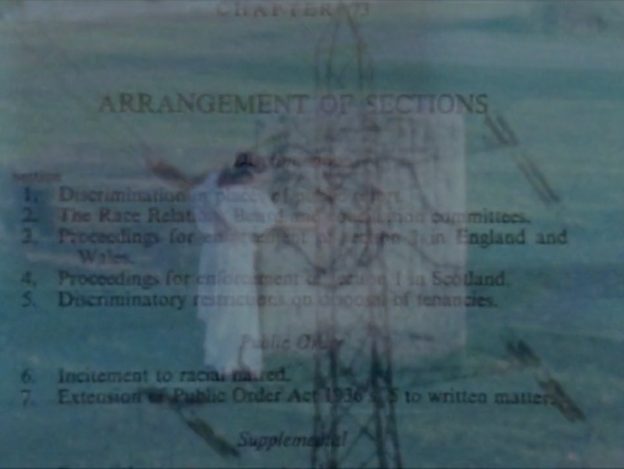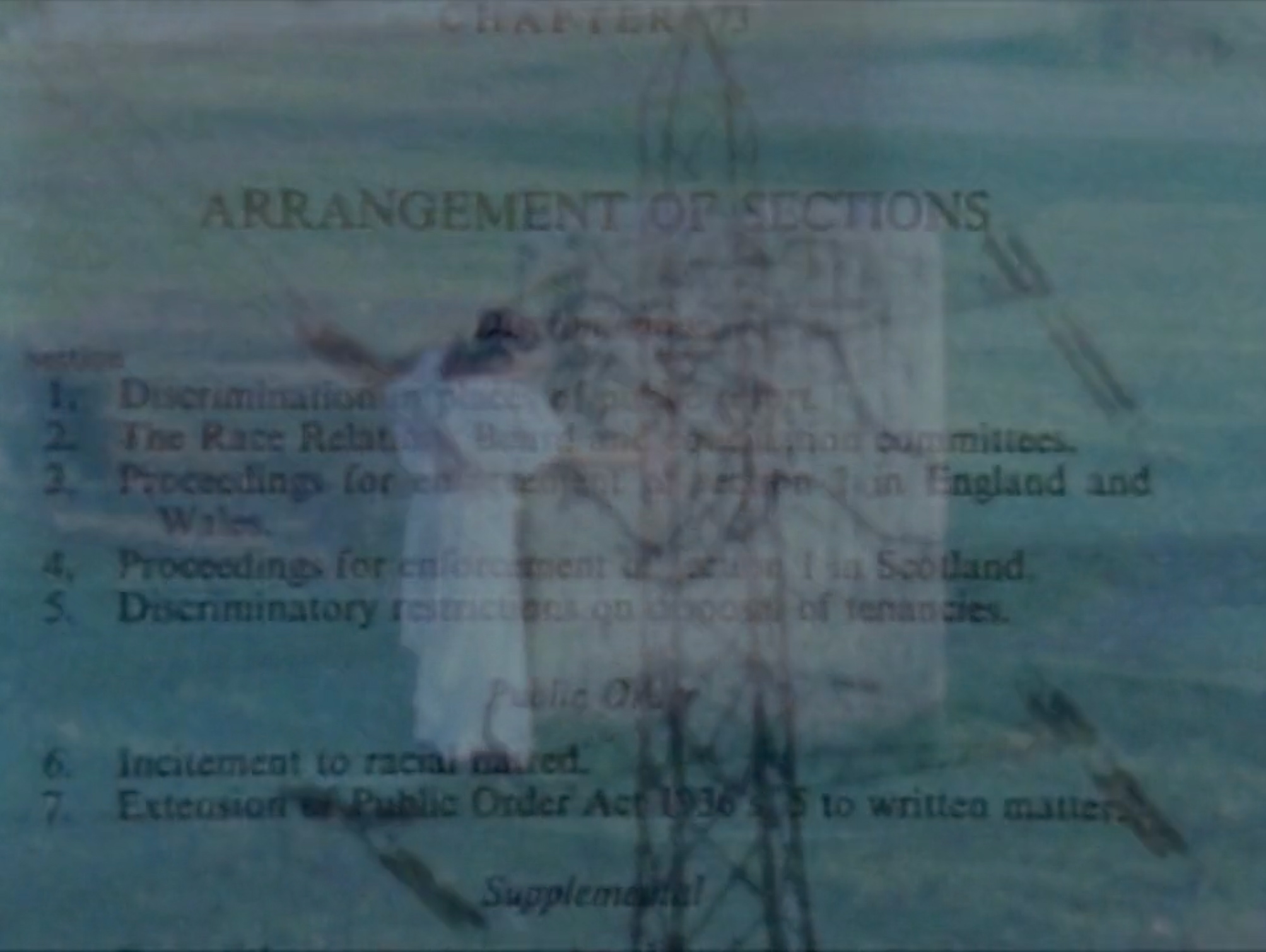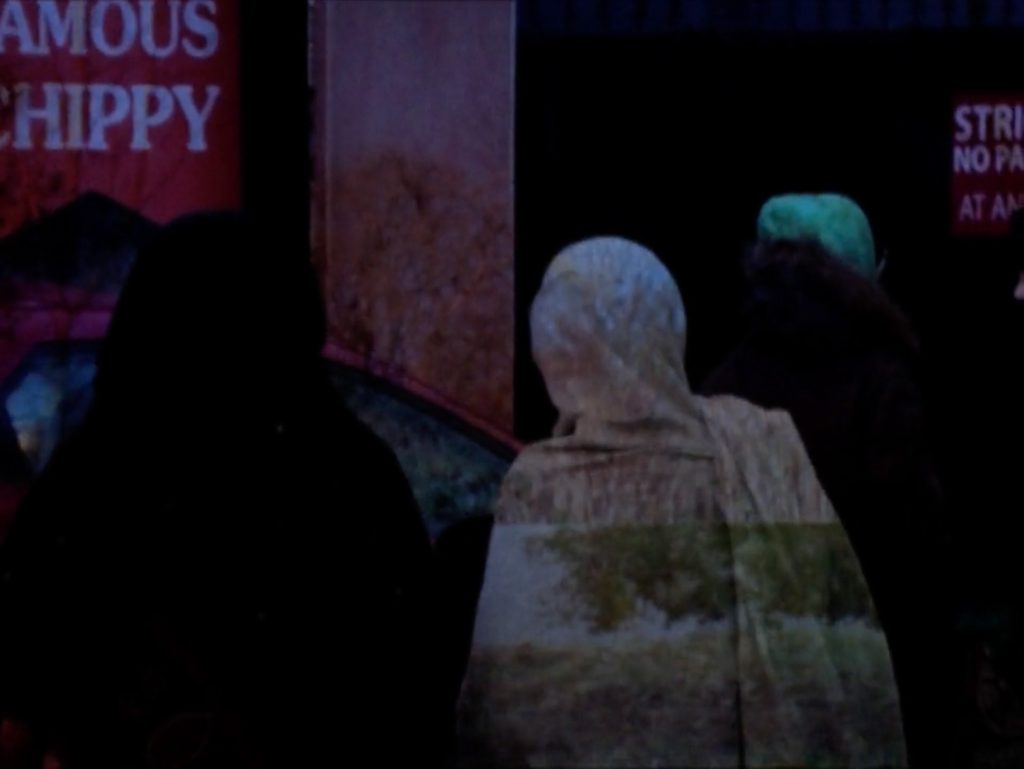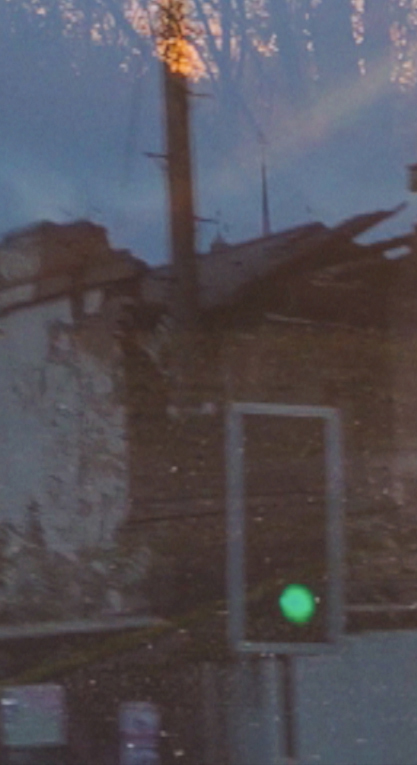
IN-BETWEEN THE LAW AND TRANSGRESSION: DESIRE, ETHICS, AND SYMBOLIC DESTINY IN PSYCHOANALYSIS
Word Count: 3,162 |
Download this article
by •
010: JUDGE
with INSIDE OUT
a film by SARAH KHAN
Read this essay in French — Read this essay in Russian — Read this essay in Spanish
Abstract: Comprised of fragments of bible verse, narration of the author’s own analysis, Lacanian textual exegesis, and speculative theory, “In-Between the Law and Transgression” interrogates the relationship between desire, the (symbolic) law, ethics, and destiny in psychoanalysis. The piece draws on the author’s experience as an analysand and analyst-in-training, and formally experiments with a variety of modes of writing that comprise psychoanalytic discourse as a means to explore the themes and concerns at play.
I would not have known what sin was had it not been for the law. For I would not have known what coveting really was if the law had not said, ‘You shall not covet.’ But sin, seizing the opportunity afforded by the commandment, produced in me every kind of coveting.
– Romans 7.7-8.
The figure of the law has a special significance in psychoanalysis, as it intimates not just the law that regulates the social body, but the network of signifiers by which the symbolic is constituted. It is the installation of this symbolic law that allows the lacking, and hence desiring, subject to be constituted as such. This is the infamous act of castration, as the introduction of “the third” (the signifier) that separates the child-mother dyad and allows the subject to enter into the symbolic, and the social order in turn, as a desiring subject. Through giving up access to their enjoyment of the mother and her body and taking up language, the infant can assume subjecthood and become a full member of the social order. The act of castration though, of course, is a traumatic one, leaving its mark on the subject. As psychoanalysis understands it, the law does not determine the subject, but rather the subject exists in a dialectic relation to it. Our desire exists in a dynamic tension with the symbolic law, as the symbolic order allows desire to be expressed within a libidinal economy of exchange relations, yet at the same time our desire always reaches beyond it towards the forbidden or lost object. While this object can never be accessed, or even known as such, it nevertheless sustains desire as lack, which slides metonymically from signifier to signifier, thus allowing for the whole play of tragic drama that is the human experience.
This essay explores these questions of the law, desire, transgression, and ethics across various registers. Coming out of my own experiences in the psychoanalytic field as an analysand and an analyst-in-training, it proceeds by association across these various orders. Beginning with a retelling of a passage from my own analysis, it proceeds through an exegetical reading of Jacques Lacan’s Seminar VII, before concluding with my own theoretical speculation regarding the role that symbolic destiny plays in psychoanalysis, as the subject negotiates the enigma of their desire in relation to the law. While there is a thread that runs throughout, this essay proceeds as much by the superposition of recurring themes and concepts across the various fragments that make up the (w)hole as it does by logical progression. In this sense, it attempts to explore the themes in question, not just through a psychoanalytic conceptual frame, but in a psychoanalytic mode. Which is to say, a mode of writing (and thinking) that acknowledges the inherent and dynamic tensions at play in psychoanalysis, between speech and its interpretation, poetry and scientific formalization, and completeness and incompleteness, proceeding as much by way of (free) association as it does logical progression or structuration.
AN EXCERPT FROM MY ANALYSIS
If my first castration was a failure, my second was all too successful …
My father was a lawyer and a humanist. Of Jewish descent, he was a man of the book—the law, the legal precedent. For him, what was good was rational, and what was rational was good. His law remained inoperative, though, until another man instigated it, carved it into my flesh.
The teacher took pleasure in enforcing the law … obscene enjoyment. A sadist in knee high woolen socks and sandals.
Every aspect of life was regulated at the boarding school, from waking to sleep; stand at ease, stand at attention.
Nevertheless, there were gaps, moments where one could slip away and find one’s enjoyment—masturbate in the toilets, hide contraband in the woods, conspire with others, slip the fences and wander through the surrounding countryside.
At first, it was as if I broke the rules simply by accident, because my childlike desire innocently spilled over the imposed limits of the law. There would be corrections, of course, punishments: additional chores, detention, standing with my nose against the wall in the dormitory hallway late into the night wearing a cheap nylon dressing gown.
The teacher was all too ready to catch my naïve transgressions, to make them apparent, to shame me for my failings in the eyes of the law and debase me in front of my classmates. He made it clear that my failing was not just simply a failure to abide by a rule, but rather a more fundamental moral and spiritual one. This boy was a malcontent, spiritually malformed, excessively sinful.
And of course, I came to enjoy it—to transgress the law, to deign to be caught, be punished, and feel guilt and shame. In his excessive attempts to impose the law on me, to discipline my wayward soul, he showed me a pathway to jouissance.
To sin (in thought or deed), to prostrate oneself … and to repeat, again and again.
I had internalized the law now; my father’s legal formalism etched onto my soul by the excessive sadism of the teacher.
What was rational was good, and what was evil, well …
READING SEMINAR VII
Lacan’s seventh seminar, The Ethics of Psychoanalysis, is often talked about as a kind of anomaly in the development of his teachings. Sitting between his seminars on desire and transference, Seminar VII is often flagged as the point where Lacan starts to become the Lacan of the real.1 Central to the project of Seminar VII is a psychoanalytic critique of the residue of an Aristotelian “eudemonic” ethics of happiness in contemporary thought. This residue can be seen to be expressed, for example, in the all too common demand made by the analysand to the analyst for happiness—for them to be rid of the symptoms and the problems that vex them, and to be, simply, happy. For Lacan, if Freud’s introduction of the unconscious and the (death) drive tells us one thing, it is that there can be no organic coincidence between the good of the subject (of the unconscious) and the good of the individual, let alone that of the social body as a whole.2 Following Freud’s discovery, the subject itself is prefaced on a split (spaltung), perpetually at odds with itself—an antagonism expressed in the basic division between conscious and unconscious, and more explicitly in Freud’s later thought, through the destabilizing influence of the death drive. Through psychoanalysis’ central engagement with unconscious desire (or libido), we find ourselves in the realm of what Lacan calls the “monstrous anomaly,” the polymorphic drive/s that pervert every natural relation.
As Seminar VII unfolds, Lacan leaves behind the eudemonic notion of the good and turns toward two seemingly wildly distinct systems of post-Enlightenment ethical thought—Kant’s categorical imperative and Marquis de Sade’s radical libertinism. As Marc de Kesel puts it, while seeming radically opposed, these two systems that emerged in response to the ethical crisis brought about by the Enlightenment, wherein “Aristotelian and Christian morality fell into crisis,” can both be seen as attempts to construct a formal ethics grounded in reason. Indeed, while Kant and Sade’s systems differ radically in their conception of the good—das Gute (or de-pathologized “Good”) in the case of Kant, and pleasure in the case of Sade—nevertheless the emphasis on a formal logic or program whereby one is necessitated to act towards the realization of one’s ethical duty is axiomatic to both programs.3
As Marc De Kesel articulates in his Eros and Ethics, in order to ground his ethics in something beyond phenomenal appearance (and by extension a “pathological” conception of the good), Kant takes noumenal reason as a given factum. As he puts it, “without any foothold in the phenomenal realm, moral reason from the outset is forced to suppose (to postulate) itself, in its pure noumenality, as a fact.”
In such a way, while Kant’s (and Sade’s) ethical systems purport to rely on formal reason alone, the support of reason itself is something external to it, something given that lies beyond (the law), a “thing-in-itself.” For Kant, this thing-in-itself is the immortality of the soul, which is assumed as a necessary postulate, yet, in such a way, ultimately remains caught in transcendental appearances. While in Sade’s system, a brute materialist rendering of “nature” holds a similar position. Here, Lacan employs Freud’s notion of Das Ding (the thing), a pre-symbolic other, the lost object of desire that lies beyond the law and orients the subject and their libidinal economy.4 Yet this “thing” can only be understood in radically negative terms, as something that necessarily lies beyond the law and serves to ground it but can never be accessed, realized, or even known as such.
Following Freud, Lacan understands that this thing that lies beyond and orients the law has its origin in something that is irrevocably prohibited—the object of incest, the mother.5 A forbidden good (or object of desire) that, due to its position beyond the law, is supremely evil. Indeed, it is the process of passing through the Oedipus complex and being subject to castration (and in turn the symbolic and the signifier) that produces the lacking, and hence desiring, subject. De Kesel writes:
Only as something forbidden can this object generate desire and grant its consistency. This “Good” is now exclusively the forbidden “thing” and, in this sense, is evil by definition.
Here, then, we see one of the essential lessons of Seminar VII. The law at once engenders desire through producing lack, while prohibiting its ultimate realization—access to the lost or forbidden object around which the libidinal economy of the subject circles endlessly.6 In this way, the subject attempts to maintain a proximal distance that allows it to access jouissance (or enjoyment), yet prevents it from coming into an encounter with the thing which would ultimately represent the death of the consistency of the subject.7 In such a way, the law (as prohibition) is fundamental to the formation of the (desiring) subject. Yet, it does not simply determine or define their desire, but rather provides a symbolic order through which it can be expressed and maintained.
DESIRE, ETHICS, AND DESTINY
In a sense, psychoanalysis is an ethics as much as it is a therapeutics. As an ethics, it is not an ethics of the good (or happiness), not a eudemonic ethics, but rather an ethics of desire. An ethical programme wherein unconscious desire is an enigma that is worked through and with via its ongoing interpretation. Here, desire needs to be understood in terms of the Lacanian notion that “le desir de l’homme, c’est le désir de l’Autre.” This phrase, in its typical English translation, “man’s desire is the desire of the Other,” implies desire for and recognition from the Other, yet as Bruce Fink points out, the original French implies another meaning, whereby it also suggests that it is qua the other that the subject desires as such. In this sense, the subject’s desire is never simply their own, not some kernel of authentic subjectivity, but rather is always bound up with that of (little) others—familial, romantic, fraternal, collegial, or otherwise—and the (big) Other, that is, with the symbolic order that codes the social-body via the law that regulates intersubjective relations. My desires are never wholly my own; from the desire of my parents that conceived and named me, assigning me a place within the “discourse [they] bequeathed me,” to that of the broader social milieu that I was born in to with its laws, norms, cultural, and religious customs.8 It is through other/s and the Other (the symbolic order) that we desire.
The process of psychoanalytic work can, in a sense, be understood as a working through of imaginary fixations and conflicting desires that constitute the subject and their symptom, towards the assumption of one’s “mortal destiny”—their radical particularity as a subject. Here the assumption of one’s desire does not imply some kind of pure freedom or autonomy, but rather the recognition and embodiment of one’s truth or “lot”—the active assumption of a negotiated position in relation to the symbolic law. As Lacan puts it in Seminar II:
Through the analysis the subject discovers his truth, that is to say the signification taken on in his particular destiny by those givens which are peculiar to him and which one can call his lot.
Indeed, it is only by assuming their particular fate governed by a dialectic relation to the Other and the law (the symbolic) that the subject can come to the recognition of the singularity of their desire. As Santanu Biwas puts it, this is the heroic, and tragic, dimension of the psychoanalytic ethics of desire, embodied in Seminar VII in the figure of Antigone, and more broadly in the concept of até (“criminal recklessness or fatal blindness”)—which for Lacan implies the very limit between life and death. Here we can see one of the more radical renderings of the potentials of the psychoanalytic cure offered by Lacan, whereby the subject can be brought into a confrontation with, and realization of, their symbolic destiny (the particular set of signifiers that marks their being), which brings about an encounter with psychic death or subjective destitution.9 It is in this encounter through which creation ex nihilo becomes possible, whereby the subject may radically re-signify itself, and create a new way of being in the world.
1 For Lacan, “the real” (one of his three registers—the real, the symbolic, and the imaginary—which are knotted together, constituting the subject’s reality) is fundamentally understood in the negative as that which interrupts the consistency of one’s experience as a rupture or event.
2 In the tradition of virtue ethics, deriving most notably from Plato and Aristotle in a Western context, the good should be understood as the goal or ends of a program or system of ethics. For Aristotle, eudaimonia, which broadly translates into English as “happiness,” is the goal (or good) of his ethics. Here, it is assumed there is a natural coincidence between the subject’s happiness and its well-being (or flourishing), and, in turn, a harmony of/with the social order and the natural world at large.
3 The de-patholigzed “Good,” for Kant, is the Good which reason has stripped of all contingent personal desires and psychic investments.
4 Lacan appropriates this notion of Das Ding from Freud’s pre-psychoanalytic text, The Project for a Scientific Psychology, developing it further relative to his own concerns in Seminar VII.
5 Following the work of structural anthropologist Claude Levi-Strauss, Lacan saw the “incest taboo” as the only universal law, all others being contingent and culturally particular.
6 As Dylan Evans articulates, it is important to note here that for Lacan, “the law” as a “legal-linguistic structure is in fact no more and no less than the symbolic order itself.”
7 While jouissance ostensibly translates into English as “enjoyment,” as a psychoanalytic concept it involves a relation to the interplay of satisfaction and suffering, transgression, and repetition. These connotations are apparent to the original term as it functions in the Romance languages—as, for example, in the original French it holds sexual connotations, while in Italian it alludes to the act of repetition.
8 Lacan, Jacques. The Seminar of Jacques Lacan, Book II: The Ego in Freud Theory and in the Technique of Psychoanalysis 1954-1955. Translated by Slyvana Tomaselli, Norton, 1991, p. 89.
9 In the closing of Seminar VII, Lacan seems to suggest that this heroic realization of the possibility of psychoanalysis is rare, as analysands typically abandon or “betray” the singularity of their desire, and the heroism it requires, and simply return to participation in “the circulation of goods,” a more mundane existence defined by a normative mode of sublimation to the social order.
Biwas, Santanu. “Introduction.” The Literary Lacan, edited by Santanu Biwas, Seagull Books, 2012, pp. 8-34.
De Kesel, Marc. Eros and Ethics: Reading Jacques Lacan’s Seminar VII. Translated by Sigi Jöttkandt, SUNY, 2009.
Evans, Dylan. An Introductory Dictionary of Lacanian Psychoanalysis. Routledge, 1996.
Fink, Bruce. Against Understanding: Commentary and Critiques in a Lacanian Key. Routledge, 2014.
Freud, Sigmund. The Standard Edition of the Complete Psychological Works of Sigmund Freud, Vol. I: Pre-Psychoanalytic Publications and Unpublished Drafts. Translated by James Strachey, Vintage, 1953.
Lacan, Jacques. “The Ethics of Psychoanalysis,” 1959-1960: The Seminar of Jacques Lacan: Book VII. Translated by Dennis Porter, Norton, 1992.
Lacan, Jacques. The Seminar of Jacques Lacan, Book II: The Ego in Freud Theory and in the Technique of Psychoanalysis 1954-1955. Translated by Slyvana Tomaselli, Norton, 1991.
Inside Out is a short film that travels the liminal space from disconnect to embodiment. The film combines an autobiographical monologue and footage of British-Pakistani culture to form a poetic montage on the complexity and alienation of navigating a cross-cultural existence in a Western society.
– Sarah Khan
RICHARD B. KEYS writer
Richard B. Keys is an artist, writer, educator, and psychoanalyst-in-training whose work operates at the intersection of the psychoanalytic clinic, the arts, and cultural theory. He is interested in the unique capacity of psychoanalysis as a mode of thought, writing, and speech that cuts across social, political, and psychic registers. His writing explores the relationship between literature and scientific formalism that is inherent to psychoanalysis as a linguistic practice. As a writer, his essays have been published by Counterfutures (NZ), Plates (US/NZ), Identities (MK), and &&& (US/DE). He is based in Aotearoa, New Zealand, where he operates a private clinical practice and sees patients internationally.
SARAH KHAN artist
Sarah Khan is an artist whose practice spans experimental film, text, sound, and performance. Drawing from her lived experience and positionality, Sarah’s works explore the intersections of cross-cultural identity, personal history, and belonging. She is interested in the periphery; undoing exclusion and dismissal of narratives that exist beyond central understanding; traversing the ways in which displacement is confronted by the “othered” in a context of Western homogeneity. Sarah is a co-founder of the collective Baesianz that centers artists of Asian heritage.
© Copyright for all texts published in Stillpoint Magazine are held by the authors thereof, and for all visual artworks by the visual artists thereof, effective from the year of publication. Stillpoint Magazine holds copyright to all additional images, branding, design and supplementary texts across stillpointmag.org as well as in additional social media profiles, digital platforms and print materials. All rights reserved.








